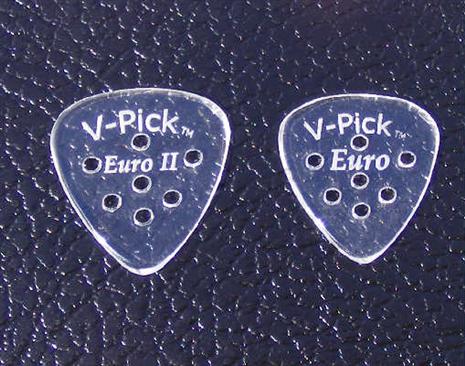I have had some time to use the V-Picks Euro and Euro II, so here we go with the review…
V-Picks is a pick manufacturing company based in Nashville, Tennessee, that produces cast acrylic guitar, mandolin, and bass picks at a starting price point that I would classify as the so called “boutique” level of guitar picks. All of the V-Picks that I have had the pleasure of trying have been very well made, and are nice to look at.
I emailed Vinni Smith, the company’s owner, for some information on how their picks are made and this is what he had to say.
The Euro and Euro II picks are made of cast acrylic. Cut out with a laser machine and then hand buffed on a bench grinder. Then heat treated, heat tempered, and buffed with a flame. A lot of hand work is done as with all of our picks. I designed the Euro for the Jazz III players, so they would have another option. Small, yet a huge tone and fast action. I think much faster action than the Jazz III.
The V-Pick Euro and Euro II are two different sizes, but the same thickness and relative shape. The Euro II is the larger of the two. They are made of clear acrylic with seven holes drilled through the picks. The holes are a feature I really like, as they do help with gripping the pick more securely with your fingers. I did not have any problem with dropping these picks or having them fly out of my fingers while playing.
Euro Pick Specs:
- Gauge: 1.5 mm (from my measurements the pick I have is a hair thicker than 1.5 mm)
- Material: Cast Acrylic
- Dimensions: 15/16″ wide x 1″ long
- Shape: In-between a Jazz III and a Regular Fender 351 pick
- Tip: Rounded and Smooth Beveled
- Price: $4.00 Each
Euro II Pick Specs:
- Gauge: 1.5 mm
- Material: Cast Acrylic
- Dimensions: 1″ wide x 1 1/8″ long
- Shape: Close to a Regular Fender 351 pick but a tad shorter
- Tip: Rounded and Smooth Beveled
- Price: $4.00 Each
I initially chose the Euro and Euro II to try first because I really liked the tone these picks produced (yes other V-Picks do sound different than these) especially when using a clean tone or light overdrive while playing electric guitar.
From my experience the Euro and the Euro II do allow you to play faster cleaner lines without any additional practice than what you can do with your favorite Jazz III pick. Some of you may notice some acrylic pick chirp with these picks, but I found a slight change in picking technique/angle mitigated this issue. Did I mention you can play faster without any additional practice? I did! That should get plenty of people excited about trying these picks just for that added feature alone.
I used both the Euro and Euro II picks for my electric guitar practice at home and in a several band situations for live performance. I found I really liked the big fat tone of the Euro II when I practiced at home, but when playing in a band situation with two electric guitars, acoustic guitar, keyboard, bass and drums I quickly found the Euro II to be too much pick for the job. The sound was too big and thick for what I wanted to hear, so I switched to the smaller Euro V-Pick which gave me the more focused sound I was looking for. It is interesting to find what works at home doesn’t always work with a full band.
I have found V-Picks do not wear down very quickly, so you can plan on using the Euro or Euro II for a long time unless you misplace or lose them.
For playing Jazz music I don’t think there is a better pick out there than the Euro. At least not one that I have tried to date, and I have tried quite a few. For softer rock music the Euro is a good pick as well. For harder rock the Euro II is a good choice if you want a heavy, thick pick attack. For speed picking these picks do well, but I have found some other picks to be better, which I will reveal in forthcoming pick reviews.
Give the Euro and Euro II a try if you currently like the Dunlop Jazz III. You may just find your next favorite pick.
Keep pickin’!





